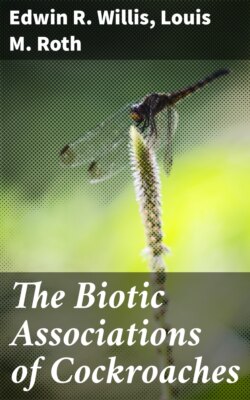Читать книгу The Biotic Associations of Cockroaches - Edwin R. Willis - Страница 9
На сайте Литреса книга снята с продажи.
FUTURE WORK
ОглавлениеTable of Contents
After having examined thousands of references on cockroaches, we are impressed by how little is known about the biology of most species. As a conservative estimate there are 3,500 described species of Blattaria (J. W. H. Rehn, 1951). In our literature survey we found records of biotic associations for about 400 species. Unfortunately, many of these records contain only a sentence or two of biological information. Our detailed knowledge of cockroaches is based on studies of the few domiciliary pests that man attempts to eradicate. Comparable studies of the bionomics of the less-well-known species should add much valuable information to our knowledge of this ancient group.
Our understanding of most predator-prey and parasite-host relationships has barely progressed beyond the taxonomic stage. The total effect of predators and parasites in limiting natural populations of cockroaches remains to be determined. It is still not known how, for example, predatory or parasitic wasps select specific cockroaches from among all other insects. Secretions produced by certain cockroaches (e.g., 2-hexenal by Eurycotis floridana) will ward off certain predators. The identities and biological activities of most cockroach secretions are unknown, but the use of protective chemicals against predators may be widespread among cockroaches. If so, how effective are these repellents in protecting the individual or the species? It is not known whether cockroaches are protected by apparent mimetic resemblances to other arthropods. There is no experimental proof that insect parasites can successfully attack the eggs of cockroaches that incubate their eggs while they are being carried by the female.
It is conceivable that biological control of cockroaches might be achieved in limited areas such as man-made structures or sewers, but this possibility has not been thoroughly explored. It would be informative to know what effects, if any, organisms such as bacteria, Protozoa (e.g., gregarines), intestinal nematodes, or other helminths have on cockroaches. Possibly pathogenic microorganisms can be used for biological control of cockroaches; this approach seems to have been little explored.
Associations of colonial cockroaches (e.g., Cryptocercus spp.) may be truly familial or they may merely result from gregariousness. Newly hatched nymphs of species that carry their oöthecae until the eggs hatch cluster near the mother. This may be a response to the mother as such, a search for shelter beneath the nearest object (thigmotaxis? or negative phototaxis?), or there may well be yet another explanation. Tepper in 1893 stated that the native cockroaches of Australia are almost wholly carnivorous; little supporting evidence for this claim has been brought forward since that time. The apparent supersedure of one species of domiciliary cockroach by another may result from antagonism between different species, or it may result from more rapid breeding and more effective utilization of available food and space; but which? Several species of cockroaches are frequently found associated with certain plants (e.g., bromeliads and bananas); the ecological relations in these associations remain to be determined. Many of the obscure associations between cockroaches and other insects, spiders, birds, and burrowing animals have never been adequately defined. The factors influencing cannibalism have never been thoroughly investigated experimentally. These are only a few ideas for future work that have occurred to us during the preparation of this review. We hope that these suggestions as well as other questions that may occur to readers will stimulate further research in areas where it is obviously needed.
